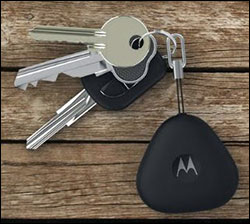The following are news announcements made during the past week by the following organizations:
Impinj;
Xerafy;
Secura Key;
Tageos;
Lancom Systems; and
Motorola.
Impinj Opens Retail Experience Center
Impinj has announced the opening of the Retail Experience Center (REC), designed to test and showcase item connectivity applications in real-world retail shopping scenarios. At the 11,000-square-foot REC, located in a former grocery store in Seattle, retail executives, members of the media and others can visit in order to learn about and engage in a wide range of demonstrations and interactions that highlight the value of RFID-based item-level intelligence data, according to Impinj.
One of the REC’s goals, Impinj reports, is to demonstrate how item-level intelligence enables omnichannel fulfillment, digitally enhanced shopping experiences, loss identification and behind-the-scenes data analytics about shopper activity. In addition, the REC showcases hands-on demonstrations featuring a variety of retail merchandise, with always-on inventory monitoring, real-time location tracking of items, and the ability to engage customer experiences through interactive product displays and fitting rooms.
A group of select sponsors are providing key technology and merchandise, including CreativeSystems, Data2, Intel, Mervin Manufacturing and Smartrac. The Impinj REC is stocked with Mervin’s 2014-15 line of Lib Tech snowboards, apparel and accessories, all tagged with RFID. Hangtags and adhesive labels supplied by Smartrac provide unique identifiers for each Lib Tech item. The REC is equipped with Impinj xArray gateways, which provide hands-free, always-on monitoring of tagged items. The information collected by the xArray gateways allows for real-time visibility into product identity, availability and location within a store, while an interactive snowboard display engages visitors with product information as items are placed on a special rack. Smart fitting rooms provide visitors with additional information regarding related products as they bring items in to try on. RFID-enabled tag solutions for jewelry are provided by Data2, and workflow applications from CreativeSystems showcase item intelligence applications on consumer-grade mobile devices. Intel supplied the tablet computers used within the REC.
Xerafy Debuts Slim Trak Tag
Xerafy has announced a new passive ultrahigh-frequency (UHF) RFID tag designed to provide customers with the flexibility to use the tag in multiple industrial environments and geographies with different RF regulations. The Slim Trak tag operates across the global frequency band and complies with the EPC Gen 2 and ISO 18000-6C international standards.
According to Xerafy, the new tag will strengthen its product offering for such applications as tool tracking, IT asset management, weapon tracking and more. It features a small footprint, measuring 56.5 millimeters by 5.95 millimeters (2.2 inches by 0.2 inch), and is only 1.3 millimeters (0.05 inch) thick. It offers an on-metal read range of up to 6.5 feet and an off-metal range of up to 4.9 feet. The tag has an IP68 rating, signifying that it is dust- and waterproof, and is designed to withstand impacts, as well as temperatures ranging from -40 degrees to +185 degrees Fahrenheit (-40 degrees to +85 degrees Celsius), which makes it suitable, the company says, for applications that may involve heat shrinking, molding and strong vibration.
Secura Key Adds Lockdown, Door-Status Features to Access-Control Software
Secura Key, a California-based provider of electronic access-control and RFID products for security, asset-management and automatic data collection (ADC) applications, has announced the availability of its SK-NET Version 5.20 access-control software, featuring two new features: system lockdown and real-time door status reporting. According to Secura Key, the updates are a response to requests from dealers, system integrators and end users, such as security officials at schools, courts, government offices and other facilities.
The system-lockdown feature is designed to provide security officials with the ability to lock or disable groups of doors with a single command, in order to react to internal or external threats. It provides three progressively more secure lockdown levels. Level 1 – Global Lock cancels all manual or door zone unlock commands. Level 2 – Global Inactive for Lockdown Group performs Level 1 and also places all doors in inactive mode. And Level 3 – Global Lockdown for Lockdown Group also disables REX or remote-open inputs. The SK-NET Version 5.20 software provides real-time door status reporting by means of an icon: A green icon indicates controlled doors are unlocked, yellow indicates doors are held or propped open, red indicates doors are forced open, and no color indicates all controlled doors are secure.
The new features work with either Secura Key’s SK-ACPE-LE or NOVA.16 (SK-MRCP) multi-reader access-control panels and smart readers for proximity and contactless smart-card technologies.
SK-NET allows the designation of override cards, Secura Key reports, which can be issued to campus police officers, or first responders such as police or EMTs. The override cards allow access to any reader, whether inactive or locked, providing authorities with the means to capture or neutralize an assailant, the company explains.
Tageos Announces Availability of UHF RFID Labels With Monza R6 Chips
Tageos, a manufacturer of RFID labels comprising a paper-only substrate and a printed antenna, has announced the availability of EPC Gen 2 passive ultrahigh-frequency (UHF) RFID labels made with Impinj Monza R6 RFID chips. The Monza R6, unveiled last April (see New Impinj Chip Promises Higher Sensitivity, Read Range and Flexibility), is designed to make tags more sensitive than those employing other chips, with a longer read range and new features aimed at increasing the yield of properly functioning tags during manufacturing and encoding processes. According to the company, the Monza R6 can be encoded at a rate of 32 bits per 1.6 milliseconds (32 bits is the most common length of data chunks used when encoding with the EPC Gen 2 Blockwrite command).
The EOS-300 R6, designed for general use, is suitable for all apparel product categories and offers a comfortable tag size for printing product information, measuring 54 millimeters by 34 millimeters (2.13 inches by 1.34 inches). The EOS-400 R6 measures 74 millimeters by 21 millimeters (2.91 inches by 0.83 inches) and is specially designed for apparel-tagging needs, Tageos indicates. The EOS-500 R6 measures 100 millimeters by 26 millimeters (3.94 inches by 1.02 inches) and is the most powerful tag in the lineup. According to Tageos, this tag is suitable for applications requiring a high reading distance, such as carton or pallet tagging and identification in retail industry supply chains.
Also included in the R6 lineup is the redesigned EOS-210 label, which had been reworked to better meet the requirements of customers, particularly those in retail apparel, Tageos reports. With a reduced form factor of 45 millimeters by 30 millimeters (1.77 inches by 1.18 inches), it is suitable for tagging a variety of small fashion items, such as poly-bagged items, men’s and ladies’ underwear, and related accessories, and meets retailers’ critical needs of smaller RFID labels, the company says. The EOS-210 is also available with NXP Semiconductors‘ Ucode 7 chip.
“A large number of fashion brands have shown an interest in our 100 percent paper-based RFID labels especially with the increased tag performance conveyed by the Monza R6 chip,” said Matthieu Picon, Tageos’ CEO, in a prepared statement. “Many of them were impressed and have started the process of switching to the latest tag versions. The cost savings gained by Tageos customers who turn to a single vendor for all their labeling needs add up to the savings they achieve on each Tageos label, which are up to 30 percent lower cost than competing plastic inlay-based tags.”
Lancom Systems’ New Device Combines Wi-Fi, Bluetooth Beacon and Electronic Shelf Label Functionality
Lancom Systems, a German manufacturer of networking solutions for the commercial and public sectors, has introduced its new E-series access points that support the simultaneous operation of three different radio technologies: Wireless LAN (Wi-Fi), electronic shelf labels (ESL) and Bluetooth Low Energy (Bluetooth Smart) beacons. The benefits, the company reports, are lower costs, longer service life of the electronic shelf labels, and a high degree of sustainability. The solution is the result of cooperation with Austrian ESL specialist imagotag.
The new system is designed to address challenges inherent in existing ESLs that required the costly installation and operation of a dedicated infrastructure, according to Lancom Systems. In addition, the company notes, existing wireless local area networks (LANs)—which are prevalent in retail—also created interference, since Wi-Fi and ESL technologies both operate in the same frequency band (2.4 GHz).
Lancom explains that it has fine-tuned the Wi-Fi and ESL functionalities to provide interference-free parallel operation. In addition to being equipped with wireless LAN and ESL radios, a Lancom E-series device includes a built-in Bluetooth beacon module and can thus transmit a configurable beacon ID. The integration of a Bluetooth beacon allows retailers and operators of shopping malls to implement innovative location-based services, such as location-dependent push marketing, indoor navigation, and business intelligence capabilities that can analyze customer walk paths so retailers can optimize a sales floor’s layout.
The new E-series comes in two models: the L-322E Wireless and the L-151E Wireless. The L-322E features two integrated IEEE 802.11n WLAN radio modules for the parallel operation at 2.4 and 5 GHz with up to 300 Mbps. The L-141E features a single WLAN module based on IEEE 802.11n for the operation at 2.4 GHz with up to 150 Mbps. Each model contains an integrated radio module for updating Lancom Wireless ePaper Displays, the integrated Bluetooth beacon technology, and one Fast Ethernet connector with Power-over-Ethernet based on IEEE 802.3af.
The new Lancom E-series access points are available now from specialist resellers. Also available are imagotag’s electronic shelf labels, as well as the central server for controlling the ESLs.
Motorola Unveils Keylink, a Bluetooth-enabled Tag for Tracking Items
Motorola has unveiled Motorola Keylink, a smart keyfob that functions as a Bluetooth Smart RFID tag to enable iOS and Android device owners to track down their smartphone, keys or other misplaced objects. Keylink works in conjunction with the Motorola Connect App, which can be downloaded from Google Play or iTunes.
Keylink is designed to be attached to a keychain. If a user misplaces his or her cell phone, Motorola explains, he or she can press a button on the Keylink to make the phone ring up to 100 feet away. Likewise, if keys become misplaced, the user can utilize the Motorola Connect App to make Keylink ring.
The replaceable coin cell battery lasts upwards of a year, the company reports. Available now from Motorola.com and T-Mobile, the Keylink is priced at $25.





